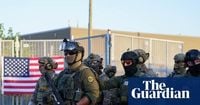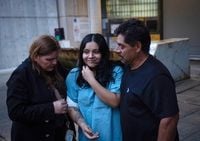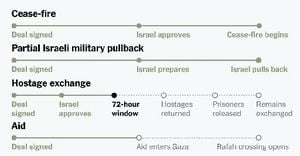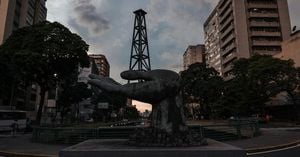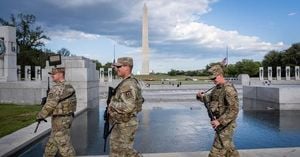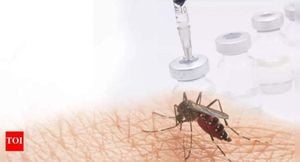On a tense Saturday in early October 2025, the streets of Chicago’s Brighton Park neighborhood became the scene of a violent confrontation that would quickly reverberate through city courts, immigrant communities, and beyond. At the center of it all was Marimar Martinez, a 30-year-old Chicago resident who was shot five times by U.S. Border Patrol agents after allegedly ramming their vehicle during an immigration enforcement operation—an incident that has since sparked heated debate over law enforcement tactics and protester rights in the era of the Trump administration’s “Operation Midway Blitz.”
The events unfolded on October 4, as federal agents conducted immigration sweeps on Chicago’s Southwest Side. According to prosecutors, Martinez and 21-year-old Anthony Ian Santos Ruiz joined a convoy of cars trailing the agents, broadcasting the pursuit live on Facebook. Martinez was reportedly “laying on her horn” and “yelling loudly” at officers as the chase moved toward the intersection of 39th and Kedzie. The situation escalated when both Martinez and Ruiz allegedly used their vehicles to ram the Border Patrol SUV. In the chaos that followed, a Border Patrol agent exited the vehicle and fired multiple shots, striking Martinez five times.
Despite her injuries, Martinez managed to drive about a mile to a repair shop, where paramedics found her and rushed her to a local hospital. She was treated for gunshot wounds and released soon after. Ruiz, meanwhile, was located and detained at a nearby gas station. Both were indicted by a federal grand jury on October 10 for using dangerous weapons to interfere with federal officers in the course of their official duties, as reported by Reuters and the Chicago Tribune.
The official account from prosecutors paints a picture of an aggressive act against law enforcement. They allege that Martinez was armed and that the agents fired in self-defense after she rammed their vehicle. The charges—impeding a federal officer with a deadly weapon—carry serious implications, and an arraignment for Martinez was scheduled for the week following the indictment. Ruiz faces the same charge.
But Martinez’s attorney, Christopher Parente, tells a different story—one that has only heightened the controversy. According to Parente, he has reviewed body camera footage from the incident, and what he saw “contradicts the prosecution’s account.” In a statement echoed by several outlets, Parente said the footage captures a Border Patrol agent, hands on his assault rifle, telling Martinez, “Do something, bitch,” just before opening fire. The footage, however, has not been released to the public, leaving much of the incident shrouded in uncertainty and fueling calls for transparency.
“Marimar will plead not guilty,” Parente announced, emphasizing that the available evidence tells a more complicated story than the government’s version. The question of whether Martinez was armed at the time of the shooting remains central to the case. While prosecutors maintain she posed a threat, her defense suggests the use of force by agents was excessive and unprovoked. The grand jury indictment, made public on October 10, scuttled a preliminary hearing that had been scheduled for that afternoon, according to the Chicago Tribune.
This high-profile case is unfolding against the backdrop of intensified immigration enforcement in Chicago, driven by the Trump administration’s expanded operations. The so-called “Operation Midway Blitz” has seen federal agents increase their presence and activity in the city, leading to a series of confrontations with protesters and immigrant advocates. The Brighton Park shooting is just one flashpoint in a broader struggle over the future of immigration policy and law enforcement’s role in American cities.
In the wake of the shooting, the city has seen a surge in protests and legal challenges. Just weeks before the Martinez and Ruiz indictments, a large demonstration outside the U.S. Immigration and Customs Enforcement (ICE) facility in Broadview turned violent, with officers deploying tear gas and pepper spray against demonstrators. Several protesters were arrested, but as the legal process played out, most charges were dropped or reduced.
On September 27, Paul Ivery, a cafeteria worker with an intellectual disability, was taken into custody during the Broadview protest. He was accused of threatening an agent and resisting arrest. However, federal prosecutors moved to dismiss the charges after confirming Ivery’s disability, and a judge accepted the motion. This followed the dismissal of charges against three other protesters, Jocelyne Robledo, Ray Collins, and Hubert Mazur, after a grand jury refused to indict or prosecutors chose not to pursue the cases further.
Only one protester from the Broadview incident, Dana Briggs, remains charged. Briggs, a 70-year-old Air Force veteran, was initially accused of felony assault for allegedly causing pain to an agent’s wrist while attempting to hand over his cellphone. But after reviewing video evidence, prosecutors reduced the charge to a misdemeanor. In an unusual move, the presiding judge ordered the government to turn over the video footage underpinning the original felony complaint. Briggs pleaded not guilty, and a trial is set for December 2025.
Amid these legal battles, the question of law enforcement accountability has come to the fore. The Chicago Tribune reports that all three agents involved in the Brighton Park shooting were equipped with body cameras, but only one camera was switched on during the incident. The footage remains under wraps, fueling speculation and demands for its release. Advocates for Martinez and other protesters argue that transparency is crucial, especially as public trust in federal law enforcement hangs in the balance.
At the same time, the federal government continues to defend its agents’ actions, insisting that officers faced a real and immediate threat. The official narrative holds that Martinez and Ruiz’s actions—ramming a government vehicle while armed—justified the agents’ use of deadly force. The prosecution’s stance is echoed by the Department of Homeland Security, which has repeatedly emphasized the dangers faced by officers during immigration enforcement operations.
The case has also become a rallying point for immigrant rights activists and civil liberties advocates. They see the indictments and the shooting as emblematic of a broader crackdown on dissent and a willingness to use force against those who challenge federal authority. The fact that Martinez was broadcasting the pursuit live on social media has only intensified scrutiny, serving as a stark reminder of how quickly confrontations between law enforcement and civilians can escalate in the digital age.
As the legal process moves forward, the city of Chicago finds itself at the intersection of national debates over immigration, policing, and protest. With Martinez and Ruiz set to face trial, and the remaining protester from Broadview preparing for court, the coming months promise to shed further light on the government’s enforcement strategies—and the limits of protest in a climate of heightened tension.
For now, the community waits, watching to see whether justice and transparency will prevail in a case that has already left a deep mark on Chicago’s immigrant neighborhoods and the broader national conversation.
